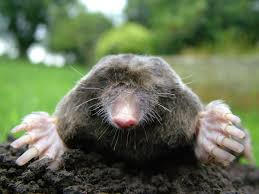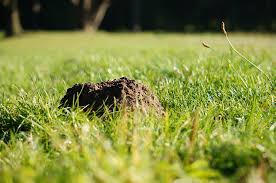
Moles



Ultralawn Incorporated
1055 East 260th Street
Euclid, OH 44132
216.731.7756
440.951.3738
Office hours Monday-Friday 9-3 call today with any questions

The mole population has been growing steadily, it seems, in the last several
years, with no signs of abatement. Those of us that love our lawns detest
these destructive moles because of the damage they cause. Moles are
voracious insectivores, and because they have a high metabolic rate, they’re
always eating. They search for earthworms, not grubs, but will consume
virtually any living critter that they come across while digging. Since moles
are insectivores, not omnivores, they don’t eat poison “peanuts” or Juicy
Fruit
®
gum!
•
As with any garden-destroying-mammalian pest, vigilance on your part
is imperative for control. Moles will feed 2 to 3 times per day. That
means they’ll go hunting in their tunnels up to 3 times each day. While
they’re tunnelling near the soil surface they physically lift the sod, and as such, these are their “surface
tunnels”. Moles will do their work at the depth where the earthworms are active. In really cold weather
and drought type weather, they’ll work deeper in the soil profile than in warmer weather. When moles are
working deep, they’re active in their subsurface tunnels (also known as “permanent tunnels”). Mounds of
soil, called “molehills” are pushed to the surface of the ground when moles dig deep. The mole’s
permanent tunnels are where they set up their sleeping quarters, and they even have an “outhouse” for
their poop.
•
Don’t set traps on top of a molehill, because all you will catch is dirt. The mole is physically pushing the
soil up the tunnel, and that soil usually trips the trap spring. Don’t place poison grubs in a molehill, for the
same reason (you’ll waste it). The best location for traps and poisons are in the surface tunnels.
•
If you irrigate your lawn regularly you should expect to be plagued with more moles than the neighbor
that doesn’t care if his/her lawn looks like a goat pasture. Moles feeding from late fall to early spring is a
nuisance because of the raised tunnels, but in hot months when the sun is shining and the temperatures
are warm, the lifted sod may actually die before you even get home from work; this is because the mole
tunnel separates the turf from its root system. A single mole will have a territory of at least 3000-5000
square feet.
•
If you’re serious about wanting to control moles, your first step is to walk your property a few times per
day, to determine where the active runways are located. Look for long, straight surface tunnels, and then
“stomp” a portion of that tunnel back down flush with the soil level. The tunnels that are pushed back up
by the mole within 12 to 24 hours are where you’ll need to set your
traps, or place your poison grubs/worms.
•
Good Links To Learn More About Moles:
-The MoleMan
-The Ohio State University




















